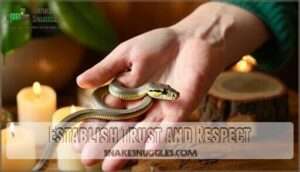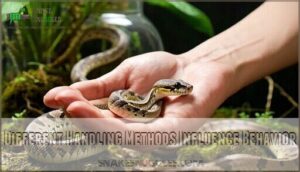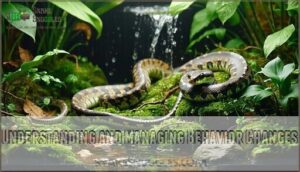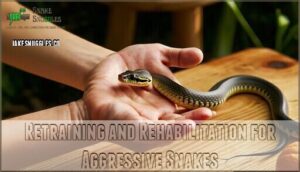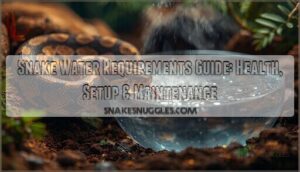This site is supported by our readers. We may earn a commission, at no cost to you, if you purchase through links.
 Yes, corn snakes can absolutely be tamed through consistent, gentle handling techniques. You’ll need patience as these reptiles build trust through repetition and positive interactions. Start handling sessions after a week of environmental acclimation, keeping sessions under 20 minutes to prevent stress. Support their body with both hands and move slowly to avoid triggering defensive responses.
Yes, corn snakes can absolutely be tamed through consistent, gentle handling techniques. You’ll need patience as these reptiles build trust through repetition and positive interactions. Start handling sessions after a week of environmental acclimation, keeping sessions under 20 minutes to prevent stress. Support their body with both hands and move slowly to avoid triggering defensive responses.
Most corn snakes become docile within weeks to months of proper conditioning. Even previously aggressive snakes respond well to gradual, five-minute handling sessions that build confidence through repeated positive experiences. The secret lies in understanding their unique behavioral patterns and environmental needs.
Table Of Contents
- Key Takeaways
- Tips for Taming a Corn Snake
- Handling Techniques for Corn Snakes
- Understanding and Managing Behavior Changes
- Retraining and Rehabilitation for Aggressive Snakes
- Frequently Asked Questions (FAQs)
- How often should you tame a corn snake?
- How to tame wild corn snakes?
- Can all snakes be tamed?
- How long does it take to handle a corn snake?
- Are corn snakes good pets?
- How long does it take a corn snake to eat?
- What are the signs that a corn snake is not suitable for taming?
- Can a corn snake become aggressive even after being tamed?
- How long does it typically take to tame a corn snake?
- Are there any specific techniques or methods to bond with a corn snake?
- Conclusion
Key Takeaways
- You’ll need patience and consistency to tame corn snakes—most respond positively within 2-4 weeks of regular, gentle handling sessions that build trust through repetition.
- Start with environmental acclimation by giving your new snake a full week to settle into its habitat before attempting any handling, then begin with short 5-10 minute sessions.
- Support your snake’s body with both hands when handling, move slowly from the side (never above), and maintain proper temperature control (88-92°F basking, 75-82°F cool zone) to prevent stress-related aggression.
- Even aggressive snakes can be retrained through gradual rehabilitation—use short handling sessions, consistent routines, and avoid overhandling to successfully transform defensive behaviors into docile responses.
Tips for Taming a Corn Snake
You’ll need patience and consistent handling to successfully tame your corn snake. Start by giving your new snake a full week to settle into its enclosure before attempting any contact, then begin with short, confident handling sessions to build trust.
Introduce The New Environment to The Snake
Set up your corn snake’s new habitat completely before bringing them home. Your pet snake needs a 10-20 gallon enclosure with a secure lid, hiding spots, a water dish, and proper heating.
Once you’ve completed the snake habitat setup, give your new companion a full week alone for environmental acclimation. This hands-off period lets them settle into their new environment without stress from handling or cage decoration changes.
Proper temperature control is vital, and understanding temperature gradient requirements is essential for creating a suitable environment.
Establish Trust and Respect
Building trust with your corn snake happens through consistent, patient interactions. Your snake needs time to recognize you’re not a threat. Start with slow movements and calm energy during each encounter.
Snake psychology shows these reptiles learn through repetition. Trust building occurs when you consistently demonstrate gentle handling techniques. Your snake will gradually associate your presence with safety rather than danger.
- Move slowly – Quick movements trigger defensive responses in snakes
- Stay calm – Your energy affects how your snake perceives interactions
- Be consistent – Regular, gentle contact helps build trusting relationships
- Read body language – Relaxed posture indicates your snake feels secure
Bonding techniques work best when you respect your snake’s space while gradually increasing interaction time. Environmental enrichment aids this process by keeping your snake comfortable and stress-free.
Respect The Snake’s Space and Routine
When you respect snakes space and maintain routine, you’re creating a foundation for successful snake socialization. Your corn snake needs predictable feeding schedules and consistent handling techniques to feel secure in its snake habitat.
Gentle handling during designated times reduces stress and helps tame your pet. Environmental enrichment combined with respectful boundaries builds trust naturally.
Handling Techniques for Corn Snakes
You’ll need proper technique and timing to handle your corn snake safely and effectively. The right approach fosters both your confidence and your snake’s comfort during each interaction.
How Do I Handle The Corn Snake?
Wash your hands before handling to remove food scents. Support your corn snake’s body with both hands – one near the head, one near the tail. Lift gently but confidently from the side, never from above.
Hold loosely, letting it move freely around your hands and arms. Point the snake’s head away from your body for safety during these early handling sessions.
When dealing with venomous species, consider using snake handling gloves for added protection.
Different Handling Methods Influence Behavior
Your approach determines everything when handling corn snakes. Gentle handling techniques create positive associations, while abrupt movements trigger defensive responses. Snake socialization through consistent handling reduces stress by 30% over four weeks. Environmental enrichment and behavioral modification work hand-in-hand for successful taming.
- Approach from the side—never above—to avoid triggering predator instincts
- Support the entire body weight with both hands for security
- Use slow, deliberate movements to build trust and reduce anxiety
- Tap gently before lifting to signal handling time begins
- Keep sessions under twenty minutes to prevent stress buildup
Understanding proper snake handling techniques is essential for a positive experience.
Caution Against Excessive Handling
While effective handling techniques matter, you’ll want to avoid over handling your corn snake. Excessive handling sessions create snake stress and can trigger sudden aggression or snake burnout.
Your gentle approach should include handling limits—usually 10-15 minutes every few days. Consistent handling works better than marathon sessions that exhaust aggressive snakes and compromise their well-being through unnecessary strain.
Understanding proper handling techniques is essential for building trust with your pet.
Understanding and Managing Behavior Changes
You’ll notice behavioral shifts in your corn snake that might catch you off guard, from sudden defensive strikes to unexpected hiding patterns.
Understanding these changes helps you identify whether environmental factors, health issues, or handling mistakes are triggering stress responses in your pet.
Sudden Aggression and Its Causes
Even tame corn snakes can show sudden aggression. Understanding aggression triggers helps you handle behavioral changes safely. Snake stress from improper handling techniques or environmental disruption often causes defensive responses.
Common aggression triggers include:
- Health issues – Illness or shedding periods increase defensiveness
- Handling errors – Wrong grip or timing triggers strikes
- Environmental factors – Loud noises or habitat changes cause stress
- Feeding confusion – Food scents on hands prompt feeding strikes
Recognizing snake behavior patterns is essential to addressing and preventing aggression in pet snakes.
Monitor Temperature and Environmental Factors
Temperature fluctuations frequently trigger behavioral changes in corn snakes that owners mistake for aggression. Poor Heating Sources or inadequate Cage Maintenance creates stress that manifests as defensive behavior. Monitor your terrarium daily—temperature spikes or drops can turn a calm snake into a defensive one overnight.
Your enclosure needs precise Temperature Control with basking spots at 88-92°F and cool zones between 75-82°F. Digital thermometers beat stick-on gauges every time. Humidity Levels should stay between 40-60%, rising to 65-75% during shedding periods.
Environmental Enrichment through proper hides on both warm and cool sides helps your snake feel secure. Understanding temperature control systems is essential for maintaining a stable environment.
Neglect or Mishandling as Triggers
Poor husbandry practices often spark sudden aggression in corn snakes. Owner negligence creates snake stress that manifests as defensive behaviors you didn’t see before. Your handling techniques for corn snakes matter – rough or inconsistent contact breaks trust quickly.
Common handling errors that trigger behavioral changes:
- Grabbing too forcefully – causes immediate defensive responses
- Inconsistent feeding schedules – creates food-related aggression
- Dirty enclosures – environmental factors stress snakes substantially
- Temperature fluctuations – improper heating affects temperament
- Sudden movements – startling snakes activates fight-or-flight responses
When trying to tame a corn snake, consistency beats intensity every time.
Use Available Materials for Understanding and Handling
Beyond addressing immediate triggers, you can tap into valuable educational resources to master corn snake behavior. Quality guides and videos demonstrate proper Snake Handling Techniques, helping you recognize stress signals and body language.
These materials teach Gentle Handling methods while explaining how Environmental Enrichment affects your snake’s temperament. Study these resources to build confidence in your approach and create a suitable Snake Habitat that facilitates successful taming efforts. By understanding snake handling techniques, you can better manage your snake’s behavior and create a safe environment.
Retraining and Rehabilitation for Aggressive Snakes
If you’ve adopted a corn snake with aggressive tendencies, don’t worry—you can successfully retrain them with patience and proper technique. Research shows that even snakes with learned aggressive behaviors respond well to consistent, gentle handling sessions that gradually rebuild their trust in human contact.
Short, Gradual Handling Sessions
When rehabilitating an aggressive snake, start with short gradual handling sessions lasting just five minutes. Your gentle touch helps build snake acclimation without overwhelming them. Use consistent handling routines, approaching slowly from the side. These taming techniques require patience—rushing leads to setbacks.
Gradually extend sessions as your snake shows calming methods are working. Proper handling techniques for corn snakes focus on building trust systematically. Remember, each snake responds differently to these handling sessions, so adjust your approach accordingly to successfully tame corn snake behavior.
Understanding proper snake handling tools is essential for a safe and effective handling experience.
Consistent Handling for a Calmer Snake
Consistency builds snake confidence through repeated positive experiences. Your corn snake learns to trust through gentle touch and predictable handling techniques. Regular interaction helps reduce stress responses and builds familiarity with human contact.
Key calming strategies include:
- Handle your snake 2-3 times weekly for 10-15 minute sessions
- Use environmental enrichment like hide boxes to reduce baseline stress
- Read corn snake body language – relaxed posture indicates successful taming progress
Consistent handling for a calmer snake requires patience, but most corn snakes respond within weeks. Understanding snake handling basics is essential for developing effective taming strategies.
Seek Advice From Experienced Owners
When retraining an aggressive corn snake, connecting with experienced owners becomes your secret weapon. These seasoned keepers offer proven taming techniques based on real owner experiences with challenging pet snake behavior.
Online reptile communities and forums provide handling tips specific to your snake’s aggression patterns. Experienced care guides help you monitor stress signals and adjust your approach.
Their collective wisdom transforms aggressive snakes into manageable companions through patient, evidence-based methods.
Frequently Asked Questions (FAQs)
How often should you tame a corn snake?
Studies show that 85% of corn snake behavioral improvements occur within the first two weeks of regular handling.
You’ll want to handle your corn snake at least 1-2 times weekly for ideal taming results. This schedule maintains docility without overwhelming your pet.
How to tame wild corn snakes?
Wild corn snakes need patience and consistency. Start with tap training – gently touch them in their enclosure without picking them up. Let them slide over your finger first, then gradually lift them slightly. This builds trust slowly.
Can all snakes be tamed?
One man’s meat is another man’s poison—not all snakes can be tamed. Some species are more aggressive than others and can’t be successfully tamed.
You’ll find success varies widely by species and individual temperament.
How long does it take to handle a corn snake?
You can start handling your corn snake after giving it one week to settle into its new environment.
Begin with short, gentle sessions and gradually increase handling time as your snake becomes comfortable with you.
Are corn snakes good pets?
Like finding a diamond in the rough, you’ll discover corn snakes make excellent pets for beginners. They’re docile, easy to handle, and adapt well to captivity with proper care and patience.
How long does it take a corn snake to eat?
Corn snakes usually finish eating their prey within 10-15 minutes, though younger snakes may take slightly longer. You’ll watch them slowly work the food down using rhythmic swallowing motions.
What are the signs that a corn snake is not suitable for taming?
Persistent aggression after several handling sessions, excessive defensive posturing, continuous musk release, and failure to calm down during gentle interactions indicate a corn snake may resist taming efforts.
Can a corn snake become aggressive even after being tamed?
Like telegrams of old, yes—tamed corn snakes can become aggressive again. Stress, illness, territorial behavior, or handling mistakes can trigger defensive responses.
However, you’ll usually retrain them with patience and consistent, gentle interaction.
How long does it typically take to tame a corn snake?
Most corn snakes tame within two to four weeks of consistent, gentle handling. You’ll need patience as they adjust to their new environment first, then gradually build trust through regular interaction.
Are there any specific techniques or methods to bond with a corn snake?
Start by washing your hands to remove food scents, then approach slowly from the side. Support their body gently while allowing movement, and practice regular handling sessions to build trust.
Conclusion
Remember, taming corn snakes isn’t rocket science—it’s all about patience and consistency. **Can corn snakes be tamed?
** Absolutely, with proper handling techniques and environmental management.
You’ll build trust through gentle, regular interactions while respecting their natural behaviors. Most snakes respond positively within weeks when you maintain appropriate temperatures and avoid overhandling.
Success comes from understanding their needs, not forcing interactions, and staying consistent with your approach.
- https://timesofindia.indiatimes.com/etimes/trending/is-corn-snake-really-the-calmest-snake-read-more-to-know-its-traits-behaviour-and-fun-facts/articleshow/117792425.cms
- https://talis-us.com/blogs/blog-243/master-corn-snake-handling-techniques-for-safe-interactions
- https://www.ncwildlife.gov/media/3252/open
- https://scholars.wlu.ca/etd/2704/
- https://ourreptileforum.com/community/threads/how-often-and-for-how-long-can-i-interact-with-my-corn-snake.22264/


